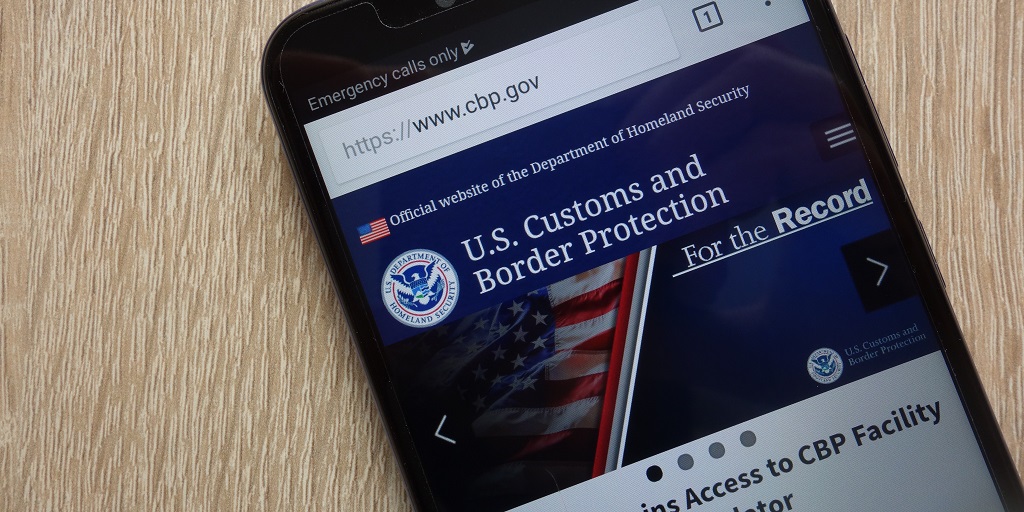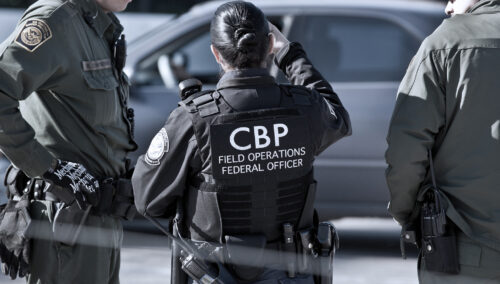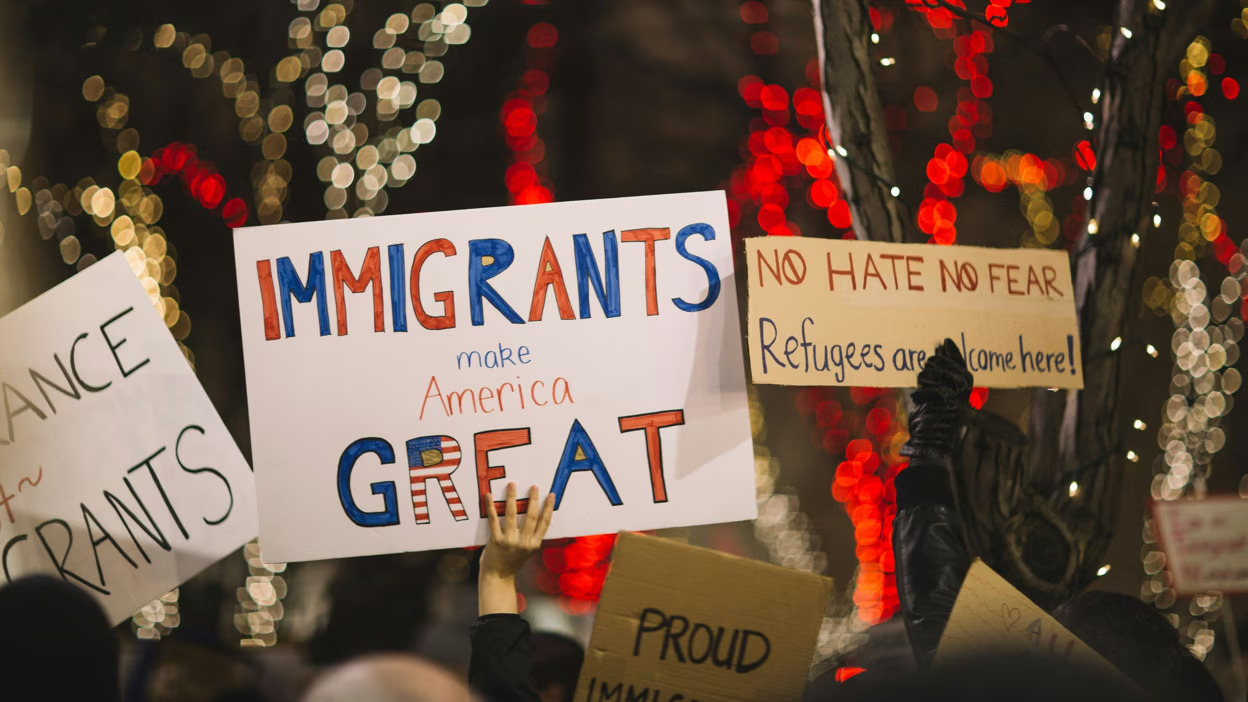In October 2020, U.S. Customs and Border Protection (CBP) launched a mobile device app called CBP One to provide travelers with access to certain CBP functions prior to their arrival in the United States. Former President Joe Biden’s administration later expanded CBP One so that migrants without entry documents could schedule appointments at designated ports of entry on the southern border. During these appointments, CBP personnel inspected migrants, and allowed them to access the U.S. asylum process. Starting in May 2023, CBP One became the primary method by which asylum seekers could enter the United States at ports of entry through the end of the Biden administration. However, upon taking office, the Trump administration immediately ended the use of CBP One for purposes of processing asylum seekers.
The use of CBP One effectively limited the number of people able to access the U.S. asylum system. The Biden administration capped the number of CBP One appointments available for processing asylum seekers at ports of entry. The Biden administration also issued a rule making migrants who crossed into the United States without going through CBP One—whether at a port of entry or elsewhere—ineligible for asylum, with very limited exceptions. Additionally, the app became the only way that Cubans, Haitians, Nicaraguans, and Venezuelans seeking to secure travel authorization to obtain parole through special programs for those nationalities (“CHNV parole”) could submit their information to CBP prior to their travel into U.S. airports.
The Biden administration’s requirement that migrants use CBP One to seek initial inspections raised concerns about both the legitimacy of conditioning access to a legal right on individuals’ use of a smartphone app, and the privacy implications of the app. It also became a flashpoint for those who disagreed with whether the President had the authority to establish a process by which asylum seekers could be allowed to enter the country and be placed in removal proceedings. As such, the Biden administration’s pre-screening process, which included use of CBP One, was the subject of litigation.
As the Trump administration ended the use of CBP One for asylum seekers, it cancelled the approximately 30,000 existing CBP One appointments held by migrants waiting to access ports of entry. The Trump administration also stopped enrolling people in the CHNV parole program, which ended the use of CBP One to facilitate access to those programs.
DHS’s CBP One Privacy Impact Assessment (PIA), a dense document that details the use and functionality of CBP One, continues to be available. However, CBP’s webpage, last modified on January 21, 2025, no longer has information about the app’s prior uses. In light of the limited information currently available about the app, this fact sheet compiles information about CBP One’s functions, litigation surrounding the app, as well as concerns about the app.
CBP One’s Functions
On March 12, 2025, the Trump administration shifted the remaining functions of CBP One to a new mobile application called CBP Home. CBP One is no longer available.
CBP One’s original uses included 1) providing travelers with access to Form I-94 information, 2) scheduling inspection appointments for perishable cargo, and 3) assisting international organizations who sought to help individuals enter the United States. CBP later added functions so that migrants could schedule appointments for asylum processing on their own, first during the time Title 42 restrictions were in place and then for processing under Title 8. Functions like applying for Form I-94 or requesting cargo inspections are now available in the CBP Home app. Notably, the CBP Home app incorporates a function that allows travelers in the United States to inform CBP of their intent to depart.
Prior CBP One Functions
CBP One became the primary way in which asylum seekers could access the asylum process at ports of entry.
CBP incrementally shifted the app’s initial model of migration management—which relied on third parties to enter information on behalf of individuals—to individuals submitting their own information.
At first, CBP One was available for nongovernmental organizations (NGOs) or lawyers to submit information on behalf of individuals seeking humanitarian exemptions to Title 42, a law the government used to expel asylum seekers based on the COVID-19 pandemic. Certain NGO staff could use the app to input, among other information, a traveler’s name, date of birth, country of origin, contact information, travel history, travel document information, marital status, and information about their parents in order to obtain an exemption from Title 42 in advance of travel, and receive an appointment for a date and time to present at a specified port of entry. Through CBP One, the agency also collected photos taken by NGO staff members of individuals seeking to be inspected and processed, so those photos could be matched with photos CBP officers captured at the processing appointment.
In April 2022, however, CBP began allowing individuals to enter their own information into CBP One. This function was first available to Ukrainians with approved authorization to travel to the United States, who could use CBP One to enter their information prior to arrival at designated ports of entry to seek parole pursuant to the Uniting for Ukraine process.
In May 2023, as restrictions under Title 42 expired, DHS published a regulation called the Circumvention of Lawful Pathways establishing new protocols to process asylum seekers at southwestern border ports of entry. This regulation made people who traveled through a third country but failed to seek asylum or other protections in those countries, ineligible for asylum in the United States. This restriction, however, did not apply to those who made appointments for processing at ports of entry through CBP One, essentially requiring the use of the app to seek asylum at the southwest border. The May 2023 regulation had exceptions if migrants showed that they did not make an appointment due to language barriers, illiteracy, significant technical failure, or other ongoing and serious obstacles. The regulation did not state how migrants who could not obtain an appointment through CBP One could access ports of entry.
To get appointments, asylum seekers would log into CBP One between 11 a.m. and 10 a.m. the following day. CBP used an algorithm to allocate the limited number of daily appointments from the people who successfully logged on. To prioritize individuals waiting the longest, a percentage of the available appointments were reserved for people with the earliest registered CBP One profiles. Users selected for appointments were notified via CBP One, and had a 23-hour window to accept the appointment. Individuals not selected for appointments could go through the same process the following day until they received their appointments.
Available information suggests that CBP continued to use CBP One in this manner until January 2025, when the Trump administration ended the use of the app to schedule appointments. The functions migrants once used to schedule appointments are no longer available. The administration also cancelled all pending CBP appointments.
CBP One allowed individuals granted humanitarian parole through country-specific parole programs to complete a pre-screening process prior to entry at an airport.
On October 19, 2022, DHS announced that Mexico had reached an agreement with the United States permitting the expulsion of Venezuelan nationals to Mexico under Title 42. In exchange, the United States created a program allowing a set number of Venezuelans with sponsors in the United States to apply for humanitarian parole from abroad. This program used DHS’ Advance Travel Authorization (ATA) process to collect information from noncitizens requesting advance authorization to enter the United States and seek a discretionary grant of parole. The ATA process required applicants to begin the application for advance parole by having a sponsor submit financial support information through a U.S. Citizenship and Immigration Services’ (USCIS) web portal called myUSCIS. The applicant then submitted their own biometric and biographical information, including their photographs, to CBP through CBP One. ATA applicants had to submit a “selfie” through the app, which CBP used at various stages of the vetting process. After an applicant entered their information into CBP One, they received the agency’s decision granting or denying advance travel permission through myUSCIS.
On January 5, 2023, after the United States reached a new agreement with Mexico expanding the nationalities the United States could expel to Mexico under Title 42, DHS announced the reciprocal implementation of new parole programs for Cubans, Haitians, and Nicaraguans, also known as CHNV, modeled after the initial Venezuelan parole program. Like individuals who entered the United States through the prior Venezuelan parole program, people seeking to enter the country via the CHNV were required to submit their information through CBP One.
However, the Trump administration stopped enrolling people in the CHNV program as the government implements President Trump’s January 20, 2025 executive order.
Transportation Security Administration (TSA) officers use of CBP One to verify certain travelers’ identities.
DHS ended the use of CBP One as a screening tool for individuals who had been paroled and released into the United States to travel domestically. CBP One allowed those who did not have valid travel documents to present to TSA for identity verification. Previously, designated TSA supervisors could take photos to verify the identity of individuals who have been authorized to remain in the country who seek to travel. By taking a photo of the individual, TSA supervisors matched travelers’ contemporaneous photo with those in the existing CBP galleries in order to verify travelers’ identities. If travelers declined to be photographed, TSA supervisors can use immigrants’ biographic information instead of a photograph to match information housed in DHS databases.
Functions still available in CBP Home
CBP Home gives travelers the ability to access information related to their Form I-94.
According to the CBP’s webpage, the function that allows travelers to complete their Form I-94s shifted to CBP Home. Form I-94 is the DHS arrival/departure record issued to travelers who are admitted into the United States. The I-94 record also contains a traveler’s anticipated departure date.
The I-94 Mobile feature offers functions similar to those currently available on CBP’s website. In the app, travelers can apply and pay for a provisional I-94 prior to entering the United States. They also can obtain an electronic copy of their most recent I-94, view their travel history, and check how long they can remain in the country. To access this information through the app, however, users are required to submit their photograph to ensure that a “live” person is accessing the app. Documents obtained through a Freedom of Information Act (FOIA) request show the agency proposed this feature as early as September 29, 2021.
CBP Home allows the scheduling of inspections of agriculture or biological products.
Travelers bringing biological products into the country, such as food items or live animals, may now use CBP Home to schedule, reschedule, or cancel cargo inspections. Merchants also may communicate with CBP officers through CBP One for additional information about their inspection appointments.
CBP One-Related Litigation
A flurry of litigation on CBP One ensued after the Biden administration implemented the May 2023 rule on asylum processing. The State of Texas filed a lawsuit challenging what it called “the Biden administration’s attempt to manage the southern border by app.” The District Court dismissed Texas’ complaint in September 2024, but Texas appealed such decision to the U.S. Court of Appeals for the Fifth Circuit, where the case is currently pending.
On the other hand, several migrant advocacy organizations also sued the Biden administration over its exclusive use of CBP One to process migrants at the border. Their lawsuit claimed that the government’s reliance on the app to process individuals, which included turning back almost everyone without an appointment, left those who could not access CBP One under precarious conditions waiting in Mexico “in the hope of obtaining scarce appointments.” Litigation in this case is currently paused as the courts sort out the impact of subsequent asylum restrictions on the plaintiffs’ claims. A separate suit challenging the validity of the May 2023 rule on asylum processing remains pending before the Ninth Circuit Court of Appeals.
What Were Some of the Concerns Regarding CBP One’s Use for Asylum Seekers and CHNV Parole Applicants?
Issues with Photo Submission Led to Disparate Outcomes. CBP One required individuals seeking appointments at ports of entry and CHNV program applicants to submit a photo or “selfie.”
An individual applying for an appointment at southwest border ports of entry was required to submit two selfies: first when submitting the biographic information to ensure the entry was done by a “live person,” then a second when logging into the system to confirm an offered appointment. Likewise, an applicant for CHNV parole also was required to submit selfies in the app to conduct liveness checks. These selfies were stored in databases to match new photos taken of applicants by CBP officers at ports of entry or compared to other photos stored in databases to vet the applicant for law enforcement purposes.
CBP One’s photo capture function proved problematic. African and Haitian asylum seekers at the U.S.-Mexico border reported that CBP One often failed to recognize people with darker skin tones during the app’s “liveness” checks. This issue, along with the lack of stable internet and modern mobile phones that supported the app, kept thousands of immigrants from properly accessing CBP One appointments.
Privacy Concerns. Advocates also raised concerns about CBP One’s photo submission requirements, and the potential for the use of those photographs to surveil individuals. Initially, the agency sought to ease this concern by allowing CBP One’s use to be voluntary. An email from a CBP official obtained through a FOIA request shows the agency assured the Office of Management and Budget that people “can still present themselves” directly at a port of entry. But, the Circumvention to Lawful Pathways clarified that individuals had to use CBP One to maintain asylum eligibility.
Further, DHS asserted that the app did not store any information locally on the device being used to access CBP One or in the app itself, but that any information entered is stored in agency databases or systems. Yet, certain information was stored in agency databases. For example, photos for some of CBP One’s functions were sent to the Traveler Verification Service system. The PIA confirms that some of this information, and photographs in particular, could be stored in government databases for up to 75 years.
By requiring travelers to submit their photos to access CBP One’s features, CBP drastically expanded its databases of noncitizens’ photos and other biographic information. The wide collection of photos and corresponding biographic information raised concerns that CBP, other DHS components, and even local law enforcement could use this information for other enforcement purposes. In the PIA, DHS acknowledged that the biometric information collected could be shared with other DHS agencies from the systems where the information ultimately resides to vet applicants prior to allowing them to enter the United States, and that such systems are also bound by privacy policies. However, DHS’ PIA fails to alleviate concerns that law enforcement agencies beyond CBP, including local police departments and sheriffs’ offices that may lack policies about limiting the use of such data, would be able to access travelers’ photos and other biographic information.
Further, CBP One had the ability to collect GPS location data. This was concerning due to the potential that such information could be used by law enforcement to track users. DHS said any risk was fully mitigated because the app captured GPS locations only “at the exact time the user pushes the submit button.” However, DHS also stated that CBP would store certain geolocation information from the app for a period of one year.
Users Were Forced to Use CBP One. CBP One became obligatory for those seeking to be processed at the border or for those applying for parole through the Cuban, Haitian, Nicaraguan, and Venezuelan (CHNV) program. DHS previously stated that the app’s use was voluntary, and the agency explained that users must consent before accessing several of the app’s features, including “just-in-time” notifications that require consent before the app deploys users’ cellphone’s camera or GPS functions. CBP officials initially said that “if someone cannot provide a photo, they can still present themselves to the [port of entry] directly.” However, this was no longer the case by the time the administration terminated this function. For example, CHNV beneficiaries were required to enter their biographic information into CBP One and provide a photo. Additionally, CBP One had become the only way for asylum seekers who traveled through a third country and arrived at the southwest border to apply for an appointment at a port of entry and maintain eligibility for asylum in the United States. The May 2023 rule stated that people who encountered technical difficulties with CBP One or who could not access the app due to illiteracy or language barriers could access asylum at ports of entry without CBP One. Nonetheless, the agency did not provide details about making these determinations.
Limited Language Access. CBP One was available only in English, Spanish, and Haitian Creole, raising concerns that users who speak other languages did not understand the app’s functions or warnings. DHS suggested that users who encountered language barriers using the app seek assistance from others to properly navigate CBP One. This purported solution failed to consider that translators may not have the acumen to translate terms of use, or privacy warnings to potential users. Furthermore, in some cases, this purported solution subjected migrants to fraud.
Lack of Transparency About Future Uses. CBP has not provided information about how the agency plans to expand the app’s uses.
Previously, there were various proposals to expand the reach of CBP One. For example, the DHS Appropriations Bill published on July 28, 2022, called upon CBP to work with USCIS and the U.S. Department of State to utilize CBP One for noncitizens to apply for asylum “from their home countries.” A prior version of the DHS PIA said that “CBP plans to eventually make the advance information submission functionality available to all individuals, including U.S. citizens, who intend to arrive at a land [port of entry].”
The Trump administration, however, terminated the CBP One app and substituted it with CBP Home. CBP Home uses functions of CBP One, such as the selfie submissions, for other purposes such as reporting travelers’ intent to depart the United States. The change came with limited advanced notice.
Conclusion
CBP Home allows travelers to access certain CBP functions once available through the CBP One app. When available, CBP One served as asylum seekers’ only way to access the asylum process, but it also exposed them to inherent risks, such as the potential for surveillance, and the possibility of disparate treatment due to the inherent flaws within the app’s functions. These functions became essentially mandatory to access these processes. Unfortunately, official information about the app failed to fully address these concerns.




